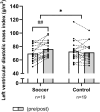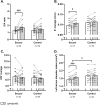15 weeks of soccer training increases left ventricular mass and improves indices of left ventricular diastolic function in previously sedentary, mildly hypertensive, middle-aged women
- PMID: 38177568
- PMCID: PMC11055800
- DOI: 10.1007/s00421-023-05399-7
15 weeks of soccer training increases left ventricular mass and improves indices of left ventricular diastolic function in previously sedentary, mildly hypertensive, middle-aged women
Abstract
Purpose: To investigate the impact of soccer training on cardiac adaptations in mildly hypertensive middle-aged women.
Methods: Hypertensive premenopausal women (n = 41; age (mean ± SD): 44 ± 7 years; height: 166 ± 6 cm; weight: 78.6 ± 11.6 kg; body fat: 43.3 ± 5.2%) were randomized to soccer training (SOC, n = 21) or control (CON, n = 20). SOC performed three weekly training sessions for 15 weeks, whereas CON had no training or lifestyle changes during the same period. Cardiac structure and function were assessed by echocardiography pre-intervention and post-intervention.
Results: Soccer training increased (P = 0.001) left ventricular mass index by 10% [95% CI 4; 15], while no changes occurred in CON (time × group interaction, P = 0.005). In addition, only SOC demonstrated a within-group increase (P = 0.01) of 8% [95% CI 2; 14] in left ventricular septum diameter. For markers of right ventricular remodelling, a within-group increase (P = 0.02) occurred for tricuspid annulus plane systolic excursion of 8% [95% CI 1; 14] in SOC only. Left atrial diameter index increased (P < 0.001) by 6% [95% CI 3; 10] after SOC, while it was unaffected in CON (time × group interaction, P = 0.02). For makers of diastolic function, SOC demonstrated a within-group increase (P = 0.02) in the average early diastolic mitral annulus velocity of 10% [95% CI 2; 19]. In addition, a reduction (P < 0.001) in mitral valve A velocity of - 19% [95% CI - 29; - 10] was observed following soccer training, which manifested in increased (P < 0.001) mitral valve E/A ratio of 34% [95% CI 16; 53] in SOC. No within-group changes were apparent in CON.
Conclusion: In sedentary, mildly hypertensive, middle-aged women, 15 weeks of soccer training increases left ventricular mass and left atrial diameter and improves indices of left ventricular diastolic function.
Keywords: Cardiac function; Cardiac structure; Echocardiography; Exercise training; Team sport.
© 2024. The Author(s).
Conflict of interest statement
The authors have no relevant financial or non-financial interests to disclose.
Figures



Similar articles
-
The impact of exercise intensity and duration for swim training-induced adaptations in cardiac structure and function in women with mild hypertension.Physiol Rep. 2024 Nov;12(21):e70116. doi: 10.14814/phy2.70116. Physiol Rep. 2024. PMID: 39487596 Free PMC article. Clinical Trial.
-
Alterations in left ventricular structure and diastolic function in professional football players: assessment by tissue Doppler imaging and left ventricular flow propagation velocity.Echocardiography. 2007 Feb;24(2):140-8. doi: 10.1111/j.1540-8175.2007.00367.x. Echocardiography. 2007. PMID: 17313545
-
Structural and functional cardiac adaptations to 6 months of football training in untrained hypertensive men.Scand J Med Sci Sports. 2014 Aug;24 Suppl 1:27-35. doi: 10.1111/sms.12237. Epub 2014 Jun 5. Scand J Med Sci Sports. 2014. PMID: 24903081 Clinical Trial.
-
Effects of Small-Sided Soccer Games on Physical Fitness, Physiological Responses, and Health Indices in Untrained Individuals and Clinical Populations: A Systematic Review.Sports Med. 2020 May;50(5):987-1007. doi: 10.1007/s40279-019-01256-w. Sports Med. 2020. PMID: 31989457
-
[Echocardiographic and Doppler echocardiographic characterization of left ventricular diastolic function].Herz. 1990 Dec;15(6):377-92. Herz. 1990. PMID: 2279732 Review. German.
Cited by
-
12 Weeks of Supervised Team Sports in Danish Municipal Health Center Lowers Systolic Blood Pressure and Increases Performance in Hypertensive Chronic Obstructive Pulmonary Disease and Type 2 Diabetes Mellitus Patients.J Funct Morphol Kinesiol. 2025 Jun 4;10(2):209. doi: 10.3390/jfmk10020209. J Funct Morphol Kinesiol. 2025. PMID: 40566459 Free PMC article.
-
The impact of exercise intensity and duration for swim training-induced adaptations in cardiac structure and function in women with mild hypertension.Physiol Rep. 2024 Nov;12(21):e70116. doi: 10.14814/phy2.70116. Physiol Rep. 2024. PMID: 39487596 Free PMC article. Clinical Trial.
References
Publication types
MeSH terms
LinkOut - more resources
Full Text Sources
Medical

